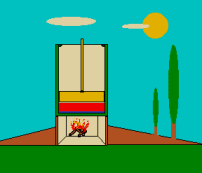
The pressure-cooker

The D. Papin Experiment
Denis Papin was famous in 1691 for the pressure-cooker ("digester") invention.
He had also invented the safety-valve to avoid the blast.
If the pressure on water differs from that of sea-level atmosphere, the boiling point is affected.
An increase of pressure outside the water raise the boiling point. The pressure cookers operate in this principle. Their steam-tight lids permit food to be boiled or steamed at temperatures higher than those can be obtained in an open vessel.
This is the reason of the more rapid food cooking.
After have helped Christian Huygens to build an engine based on the gun powder (the explosion could have created a vacuum under a piston and pressure from the outside air could force the piston down), Denis Papin had the bright idea to make the same thing with the water steam.
The Papin engine was a metal tube (closed at one end) with a piston inside.
Under the piston there was a small quantity of water which, warmed up and transformed in steam, raised the piston who reached the edge of the cylinder where was stopped by a click.
A stream of cold water was sprayed onto the cylinder.
The steam inside condensed.
This produced a partial vacuum and the outside air pressure forced the piston down (active stroke).
The tube had three roles: boiler, cylinder and steam condenser.
The steam engine will built step by step, separating those three roles.
Was T.Newcomen in 1712, independently of Papin, to build the first steam engine based on a piston inside a cylinder.